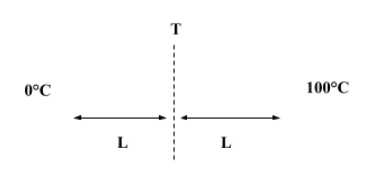
The thermal conductivity of copper is four times that of brass. Two rods of copper and brass having the same length and cross-section are joined end to end. The free end of the copper is at 0°C and the free end of brass is at 100°C. The temperature of the junction is
A. 20°C
B. 40°C
C. 60°C
D. 10°C
Answer
567k+ views
Hint: This problem can be solved using the formula for thermal conductivity. Firstly, find the thermal conductivity of brass by substituting the values in the formula for thermal conductivity. Then, use the condition given in the question and find the thermal conductivity of the copper. Equate these two equations as their left-hand sides are equal. Then solve these equations and calculate the temperature at the junction.
Complete answer:

Thermal conductivity is given by,
$\dfrac {dQ}{dt} = \dfrac {KA \Delta T}{L}$
Where, K is the thermal conductivity
Q is the amount of heat transferred
A is the area of cross-section
$\Delta T$ is the difference between the temperatures
L is the length of the rod
Therefore, Thermal conductivity of brass can be given by,
$\dfrac {dQ}{dt} = \dfrac {KA (100-T)}{L}$ …(1}
Similarly, thermal conductivity of the copper can be given by,
$\dfrac {dQ}{dt} = \dfrac {4KA (T-0)}{L}$ …(2}
Equating equation. (1) and equation. (2) we get,
$\dfrac {KA (100-T)}{L}=\dfrac {4KA (T-0)}{L}$
$\Rightarrow 100-T = 4T$
$\Rightarrow 5T= 100$
$\Rightarrow T = 20°$
Hence, the temperature of the junction is 20°C.
So, the correct answer is option A i.e. 20°C.
Note:
Thermal conductivity of a solid or conductor is defined as the measure of the ability of the solid to conduct or transfer heat through it. It is an important property while deciding which metal is to be used for a specific purpose. Copper and Aluminium have the highest thermal conductivity. Its value is lowest for steel and bronze. Materials having low thermal conductivity are considered to be good insulating material. If the thickness of the material is doubled then the thermal conductivity becomes double.
Complete answer:

Thermal conductivity is given by,
$\dfrac {dQ}{dt} = \dfrac {KA \Delta T}{L}$
Where, K is the thermal conductivity
Q is the amount of heat transferred
A is the area of cross-section
$\Delta T$ is the difference between the temperatures
L is the length of the rod
Therefore, Thermal conductivity of brass can be given by,
$\dfrac {dQ}{dt} = \dfrac {KA (100-T)}{L}$ …(1}
Similarly, thermal conductivity of the copper can be given by,
$\dfrac {dQ}{dt} = \dfrac {4KA (T-0)}{L}$ …(2}
Equating equation. (1) and equation. (2) we get,
$\dfrac {KA (100-T)}{L}=\dfrac {4KA (T-0)}{L}$
$\Rightarrow 100-T = 4T$
$\Rightarrow 5T= 100$
$\Rightarrow T = 20°$
Hence, the temperature of the junction is 20°C.
So, the correct answer is option A i.e. 20°C.
Note:
Thermal conductivity of a solid or conductor is defined as the measure of the ability of the solid to conduct or transfer heat through it. It is an important property while deciding which metal is to be used for a specific purpose. Copper and Aluminium have the highest thermal conductivity. Its value is lowest for steel and bronze. Materials having low thermal conductivity are considered to be good insulating material. If the thickness of the material is doubled then the thermal conductivity becomes double.
Recently Updated Pages
Master Class 12 Business Studies: Engaging Questions & Answers for Success

Master Class 12 Economics: Engaging Questions & Answers for Success

Master Class 12 English: Engaging Questions & Answers for Success

Master Class 12 Maths: Engaging Questions & Answers for Success

Master Class 12 Social Science: Engaging Questions & Answers for Success

Master Class 12 Chemistry: Engaging Questions & Answers for Success

Trending doubts
What is meant by exothermic and endothermic reactions class 11 chemistry CBSE

Which animal has three hearts class 11 biology CBSE

10 examples of friction in our daily life

One Metric ton is equal to kg A 10000 B 1000 C 100 class 11 physics CBSE

1 Quintal is equal to a 110 kg b 10 kg c 100kg d 1000 class 11 physics CBSE

Difference Between Prokaryotic Cells and Eukaryotic Cells




